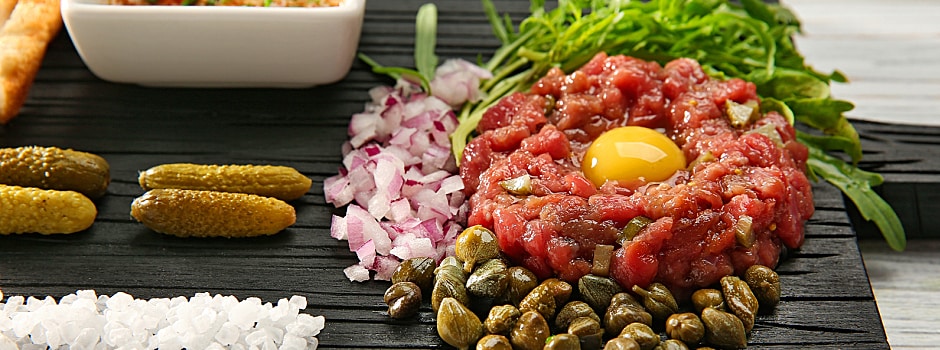It used to be that diners had to go to sushi restaurants to find raw fish dishes and to steak houses to get tartare. Luckily, the restaurant world has evolved, and raw meat dishes can now be found everywhere. If you don't serve any raw dishes at your restaurant, don't panic just yet. It's easy to add dishes, such as ahi poke, ceviche, and steak or tuna tartare, to your menu. Even better, you can easily create your own custom version of these classic raw meat dishes to win over diners with flavors they won't find elsewhere.
Ahi Poke
Pronounced po-kay, this Hawaiian dish is traditionally composed of raw chunks of yellowfin tuna marinated in a mixture of soy sauce, sea salt, sesame oil, scallions, chili peppers, and two ingredients native to the islands: limu, which is a type of algae, and roasted kukui nuts.
Natives like to serve ahi poke on a bed of red cabbage or in a rice bowl, but there are plenty of ways to play around with a dish like this. For instance, try using different kinds of fish or chilies, or incorporate an unexpected citrus flavor, such as yuzu, into your recipe. Then, opt for a bowl of wheat berries, farro, or freekeh instead of rice to introduce your customers' palates to new grains.
Ceviche
Ceviche has mysterious origins, but food historians say the raw fish dish originated during colonial times in Peru or Ecuador. The Spanish brought citrus fruit over to the New World, and the pairing of raw fish (sea bass, traditionally) with key lime and/or bitter orange juice was apparently intuitive.
You'll find different spellings of the name of this dish, but the basic idea is always the same. Adhering to tradition would call for every ceviche to be spiked with razor-thin slices of raw onions, chilies, tomatoes, and a dash of salt and pepper. However, you can take the path of successful modern chefs and put a creative spin on the dish.
Use a high-quality infused vinegar instead of straight citrus juice, add in a bouquet of freshly chopped herbs, or use beautifully segmented pieces of grapefruit, tangerine, and blood orange to tantalize the eyes of your guests before treating their taste buds.
Tartare
The dish we know today as steak tartare, which features finely chopped raw beef with minced onions, capers, strong mustard, Worcestershire sauce, and bread or toast points, used to be known as steack à l'Americaine when it became popular in the early 20th century, according to food historians.
This dish has soared in popularity recently, and many chefs have gone great lengths to distinguish their renditions of the French/American classic. For instance, you could add unexpected flavors, such as fish sauce, chopped cornichons, minced shallots, and pickled daikon radish, to give intrigue to your menu description. You could also try serving your tartare with something texturally interesting, such as a fried wonton skin, baked bagel crisp, or toasted bruschettini rubbed with garlic. You could even skip the beef altogether. Many chefs make tartare with tuna, yellowtail, salmon, and other fish in place of red meat, so feel free to experiment with different options to figure out your favorite medium for showcasing your raw talent.
Safety and Sanitation Considerations
With any raw meat dishes, whether it's ahi poke, ceviche, tartare, or simple sushi and sashimi, you'll need to adhere to strict food safety guidelines. First, only use the freshest meat, fish, or seafood from your most trusted vendors. Then make sure your employees handle meat with clean hands on clean, sanitized surfaces, and use different cutting boards for meat, poultry, fish, and produce to avoid cross-contamination. Failure to practice these food safety techniques may result in diners getting bacterial infections such as E. coli.
So while it's important to capitalize on trending raw meat dishes with a fresh, unique spin, it's more vital to execute your cooking, or in this case, food storage, handling, and preparation, in a sanitary way.
